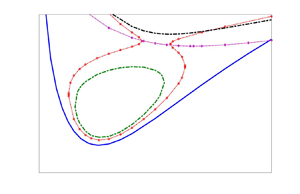No CrossRef data available.
Article contents
Linear dynamics of a thick liquid layer subjected to an oblique temperature gradient
Published online by Cambridge University Press: 22 May 2024
Abstract

The present study aims to demonstrate the application of the oblique temperature gradient (OTG) to manipulate the buoyancy instabilities and resulting mixing. To accomplish this, we consider a model consisting of a liquid layer supported by a perfectly conducting bottom wall from below and the upper surface is exposed to ambient inert gas in a shallow container. The stability analysis employs the pseudospectral method and perturbation energy budget approach. The imposed OTG consists of a negative vertical temperature gradient (VTG), which leads to unstable density stratification, and a negative horizontal temperature gradient (HTG) component responsible for the Hadley circulation, which can be utilised to control instabilities. Without the HTG, a Rayleigh–Bénard mode of instability exists due to the imposed VTG termed as a VTG mode. The imposed HTG induces a linear VTG term and a quintic polynomial VTG term in the bottom wall-normal coordinate  $y$. The induced linear VTG term reinforces the imposed VTG, while the induced quintic polynomial VTG term opposes the imposed VTG. For the vanishing Biot number (
$y$. The induced linear VTG term reinforces the imposed VTG, while the induced quintic polynomial VTG term opposes the imposed VTG. For the vanishing Biot number ( $Bi$), the induced quintic VTG term stabilises the VTG mode for the Prandtl number,
$Bi$), the induced quintic VTG term stabilises the VTG mode for the Prandtl number,  $Pr=7$. However, for
$Pr=7$. However, for  $Pr=0.01$, the Reynolds stresses associated with the Hadley circulation destabilise the VTG mode. For non-zero
$Pr=0.01$, the Reynolds stresses associated with the Hadley circulation destabilise the VTG mode. For non-zero  $Bi$, new streamwise and spanwise instability modes arise for
$Bi$, new streamwise and spanwise instability modes arise for  $Pr=7$ due to the induced linear VTG term. Physical arguments show that the unstable density stratification near the gas–liquid interface caused by the synergistic effect of the imposed VTG and the induced linear VTG term lead to the existence of the predicted new modes. The present study thus shows that the strength of the HTG can be utilised to control the instability modes and critical parameters, thereby demonstrating the utility of the OTG in manipulating the buoyancy instabilities.
$Pr=7$ due to the induced linear VTG term. Physical arguments show that the unstable density stratification near the gas–liquid interface caused by the synergistic effect of the imposed VTG and the induced linear VTG term lead to the existence of the predicted new modes. The present study thus shows that the strength of the HTG can be utilised to control the instability modes and critical parameters, thereby demonstrating the utility of the OTG in manipulating the buoyancy instabilities.
JFM classification
- Type
- JFM Papers
- Information
- Copyright
- © The Author(s), 2024. Published by Cambridge University Press
Footnotes
G.D. and S.F.B. contributed equally.





